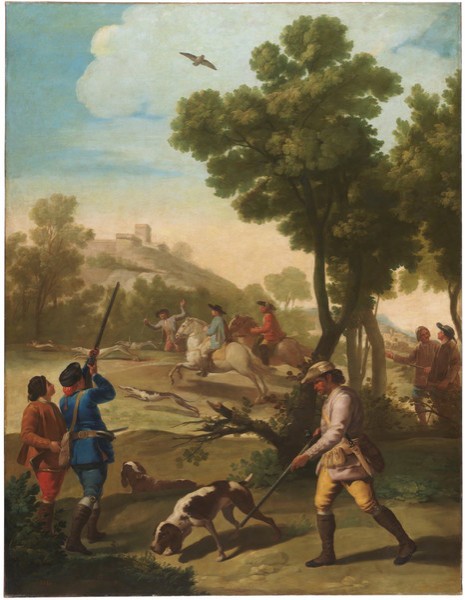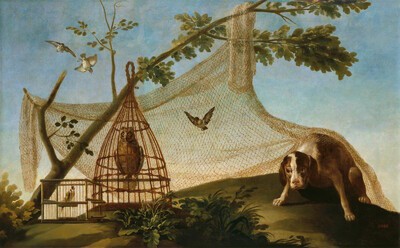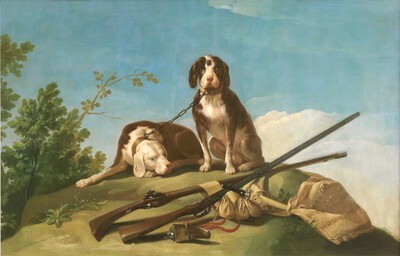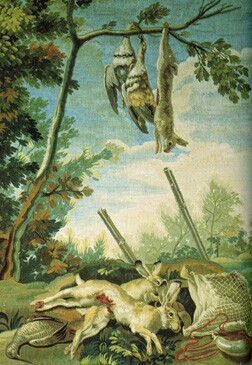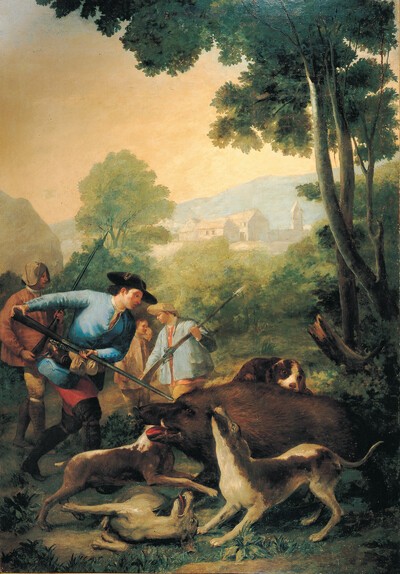- Cronología
- 1775
- Ubicación
- The Prado National Museum. Madrid, Madrid, Spain
- Dimensiones
- 290 x 226 cm
- Técnica y soporte
- Oil on canvas
- Reconocimiento de la autoría de Goya
- Documented work
- Titular
- El Prado National Museum
- Ficha: realización/revisión
- 05 Nov 2009 / 14 Jun 2023
- Inventario
- (P02857)
- Otros títulos:
-
Quail Hunt (La caza de la codorniz)
For the history of the whole series, see Wild Boar Hunt.
In addition to the different attributions made in relation to this series of cartoons and the documentation of Goya's authorship made by Sambricio, the work before us was also attributed to Zacarías González Velázquez by Vicente López in the inventory that he carried out in 1834 for Ferdinand VII's will.
Around 1856 or 1857 this piece was moved from the Royal Tapestry Factory of Santa Bárbara to the Royal Palace in Madrid, and from there it became part of the collection of the Prado Museum in 1870 (still with the attribution to Ramón Bayeu). Later it was put into temporary storage at the Treasury Building (Ministerio of Hacienda) until 1983 and in the Municipal Museum of Art in Santander from 1989 to 1990, the year in which it returned to the Prado.
The scene brings together two different types of hunting: on foot with pointer and on horseback. Although the figures are arranged around the canvas in a somewhat unnatural manner, Sambricio considers this cartoon to be the best in the series since it shows Goya's way of painting more clearly, especially in the landscape in the background and in the use and contrast of yellow, blue and red in the hunters' clothes. However, the teachings of Francisco Bayeu, under whose supervision Goya made the cartoons, still dominate. As such, the frontal compositions, the decorativeness and the depiction of the figures as types rather than as individuals are the most clearly repeated characteristics of this series of cartoons.
There exist two preparatory drawings on the same blue paper support: on the front, the hunter who is taking aim at the quail, and, on the reverse, the hunter watching at his side.
-
Goya and his timesThe Royal Academy of ArtsLondon1963cat. 66cat. 44
-
Goya joven (1746-1776) y su entornoMuseo e Instituto Camón AznarZaragoza1986consultant editorl José Rogelio Buendía. November 21st to December 20th 1986cat. 44
-
Goya. 250 AniversarioMuseo Nacional del PradoMadrid1996consultant editor Juan J. Luna. From March 29th to June 2nd 1996cat. 5
-
Permanencia de la memoria, cartones para tapiz y dibujos de GoyaMuseo de ZaragozaZaragoza1997organized by Gobierno de Aragón, Museo Nacional del Prado and Patrimonio Nacional, consultant editor Fernando Checa Cremades. From February 14th to April 6th 1997cat. 1, sec. IV
-
Goya en Madrid. Cartones para tapices 1775-1794Museo Nacional del PradoMadrid2014p. 59
-
Tapices de GoyaMadridPatrimonio Nacional1946pp. 50, 55, 63-66, 90, 193, cat. 6 y lám
-
Vie et ouvre de Francisco de GoyaParísOffice du livre1970p. 44-45, 75, 85, cat. 63 y p. 44 (il.)
-
BarcelonaPolígrafa1970vol. I, p. 244, cat. 56
-
L’opera pittorica completa di GoyaMilanRizzoli1974p. 92, cat. 52
-
Francisco de Goya, 4 vols.ZaragozaCaja de Ahorros de Zaragoza, Aragón y Rioja1980-1982vol. I, p. 77 y p. 93 (il.)
-
Imagen de GoyaMadridLumen1983pp. 56-57
-
Francisco de Goya, cartones y tapicescol. col. "Espasa Arte"Espasa Calpe1987pp. 46, 56, 63, 239, cat. 6C; p. 57 (il.
-
Francisco de Goya. Los cartones para tapices y los comienzos de su carrera en la corte de Madridcol. col. "Ensayos de Arte Cátedra"MadridCátedra1987p. 43
-
Goya. 250 AniversarioMadridMuseo del Prado1996p. 283-285, cat. 5 y p. 71 (il.)
-
Goya en Madrid. Cartones para tapices 1775-1794MadridMuseo Nacional del Prado2014pp. 58-59
